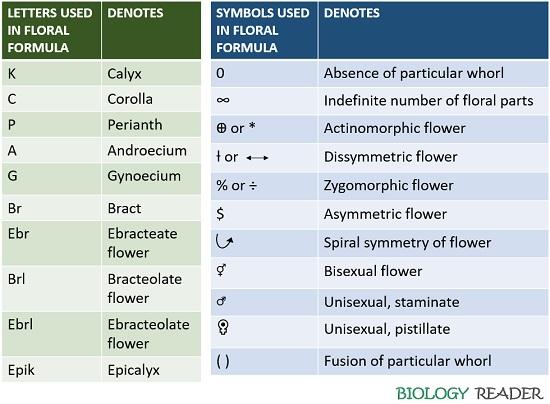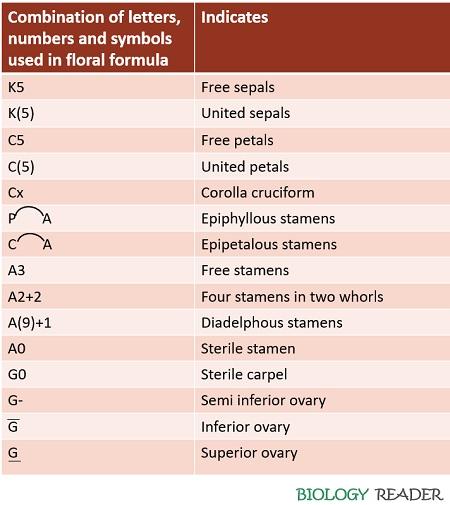A floral formula is one of the ways to summarise all the flower characteristics, which makes the use of discrete letters, numbers and symbols. The letters used in the floral formula indicate the members of the perianth and other floral parts.
Specific signs or symbols are also used to denote the properties like parentheses, aestivation, adhesion and cohesion of the flower. The number is the floral formula that indicates the overall number of each member within the floral whorl, starting from the outermost calyx, corolla, androecium to the gynoecium.
Content: Floral Formula
Definition of Floral Formula
A floral formula can define as the numeric and symbolic expression, which reveals the flower morphological characteristics by employing different symbols, letters and figures. It is the conventional method accustomed to formulate the structure of the flower. It elucidates the information about the number of whorls and a relative relationship between each other.
Components
The floral formula uses discrete letters, signs and figures to represent the specific feature of the flower.
Letters used in Floral Formula
- K: This letter denotes the sepals that form an outermost whorl called the calyx.
- C: This letter represents the group of petals that constitute the second whorl called the corolla.
- P: It is used to denote the tepals, which indicates the undifferentiated condition of the perianth members (sepals and petals).
- A: It specifies the male reproduction part or stamens, which includes the filament and anther that all together makes up the third floral whorl known as androecium.
- G: It denotes the female reproductive part, i.e. carpel, which includes the stigma, style and ovary that colloquially forms the innermost whorl called gynoecium.
- Br: It represents the bracteate condition of the flower.
- Ebr: It indicates the ebracteate condition, in which a flower lacks bract.
- Brl: It indicates the presence of bracteoles or represents the bracteolate condition.
- Epik: It represents the presence of a secondary whorl surrounding the calyx called epicalyx.
- Ebrl: It is used to indicate the absence of bracteoles or to represent the ebracteolate condition.
Symbols used in Floral Formula
- 0: It indicates the absence of a particular member in flower.
- ∞: It is generally used when the number of specific flower parts is more than 10.
- ⊕: It indicates an actinomorphic condition.
- %: It denotes a zygomorphic condition.
- ⚥: It represents the bisexuality of flowers.
- ⚦: It represents the unisexual, staminate flower.
- ♀️: This represents the unisexual, pistillate flower.

Combination of Letters, Symbols and Numbers
- K5: It shows the aposepalous condition, in which the five sepals are free.
- K(5): It shows the gamosepalous condition, in which the five sepals are united.
- C5: It represents the apopetalous condition or the presence of the five free petals.
- C(5): It represents the gamopetalous condition or the presence of five fused petals.
- Cx: It indicates corolla cruciform.
- A curve drawn over the letters P and A: It represents the epiphyllous stamens.
- A curve drawn over the letters C and A: It shows the epipetalous stamens.
- A3: It indicates the presence of three free stamens.
- A2+2: It indicates the presence of 4 free stamens, two in each whorl.
- A(9)+1: It represents the presence of diadelphous stamens (10 in number), in which nine stamens are fused in one whorl, and one stamen remains free.
- A0: Sterile stamen (staminode).
- G0: Sterile carpel (pistillode).
- G-: It represents the semi inferior ovary.
- A line over the letter G: It represents the inferior position of an ovary.
- The line below the letter G: It represents the superior position of an ovary.
- A curve over the letters G and A: It shows the gynostagium condition.
How to Use Floral Formula?
Firstly, the presence or absence of bract and bracteoles in the flowers of different families is observed and noted by using particular letters.
Then the symmetry of the flower is written according to the position of floral whorls relative to the mother axis. Flowers can be polysymmetric (actinomorphic), dissymmetric, monosymmetric (zygomorphic), asymmetric or spirally arranged. Therefore, the flowers showing different symmetry is indicated by specific symbols in the floral formula.
After that, the sex of the flower is written, i.e. whether a plant is hermaphrodite (bisexual) or unisexual. Bisexual flowers possess the male plus female reproductive parts, while the unisexual flowers either contain stamens or carpels.
Then the number of floral members starting with calyx, corolla, androecium to gynoecium is written. Here each member is denoted by using specific letters like ‘K’ represents calyx, ‘C’ represents corolla, ‘A’ indicates androecium and ‘G’ represents gynoecium. The number of each whorl is written after the following letters starting from K, C, A to G.
The number used after the letter is placed inside bracket ( ), If the particular whorl is united. But, if the floral members remain free, then the bracket is not applied. Adnation between the floral whorls is represented by drawing a curve from the top of the letters.
The position of the ovary can be shown by drawing a horizontal line above, below or in front of the letter ‘G’, which represents the inferior, superior or half inferior position of the ovary.
Examples
The floral formula can be used to describe the flowers of the particular family or the different species of flower. Let us take few examples of the floral formula to study the floral characteristics.
Floral Formula of Fabaceae Family
![]()
(%) shows that the symmetry of the flower is monosymmetric or zygomorphic. (⚥) indicates that the flower is perfect or hermaphrodite (includes stamen plus pistil). A letter ‘K’ indicates the outermost whorl, i.e. calyx and (5) shows that the number of sepals is five that are united with each other.
‘C’ indicates the second floral whorl, i.e. corolla or petals and the number after this, i.e. 1+2+(2), represents vexillary aestivation. ‘A’ means the male reproductive part or androecium, and the number after it (9)+1 shows the presence of diadelphous stamens (includes 10 stamens).
In 10 stamens, 9 filaments unite to constitute one bundle, and the remaining one filament makes up another one. The line below the letter ‘G’ indicates the superior position of an ovary, and digit 1 shows the monocarpellary ovary.
Floral Formula of Liliaceae Family

Through this floral formula, we can identify many floral characteristics. This formula indicates that the flower is bracteate, bisexual or hermaphrodite. A letter ‘P’ indicates that the sepals and petals are undifferentiated, i.e. there are three tepals in every two whorls.
Letter ‘A’ denotes androecium, and ‘3+3’ suggests there are three free stamens in every two whorls. A line below a letter ‘G’ specifies the hypogynous condition of an ovary, and the number ‘(3)’ represents the presence of three fused carpels.
Conclusion
Therefore, the floral formula is the simple way to remember the flower morphology, symmetry and sexuality etc. The best way to reflect the floral characteristics of a particular family is to learn the floral formula, by which we can also draw the floral diagram. The combination of floral formula and the floral diagram is often used to represent the floral symmetry, floral whorls and other floral characteristics.

It’s very nice.
Can someone write the floral formula for:
carex laeviconica
Thank you
I’m a new Kansas Master Naturalist 🙂
March 17, 2023